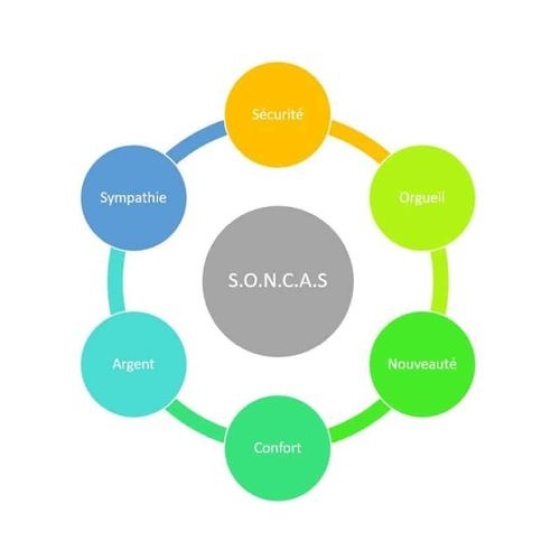RENT 2025 - Meet us at booth D33 to discover our new AI agent!

- How can you encourage a transaction using the SONCAS(E) method?
- Developed in 1993 by Jean-Denis Larradet, the SONCAS(E) method is a sales technique that helps tailor sales arguments based on buyers' underlying motivations. Let’s take a closer look.
-
Because real estate decisions are just as emotional as they are rational, this sales technique helps you analyze a prospect's or client’s true needs and tailor your response to better meet their expectations.
It’s based on six categories :Security, Pride, Novelty, Comfort, Money, Likeability, and each client may relate to several of them at once. Let’s explore each element and how to apply this method to your future real estate transactions.
1 – Security: a key factor in the buying decision
This is one of the primary psychological drivers of a purchase. People seek a stable and secure environment.To reassure your client, highlight modern security systems (surveillance cameras, motion detectors, smart alarms, etc.) that provide peace of mind, along with essentials like smoke detectors.
A solid, high-quality construction can also be reassuring. Emphasize the materials used, robust building techniques, and compliance with safety standards. For example, mention if the home is built with weather- and earthquake-resistant materials and complies with fire safety regulations.A neighborhood with a strong safety reputation is a powerful selling point as well. Share local crime statistics, community safety initiatives, and proximity to emergency services.
In summary: the client is risk-averse and needs reassurance. Offer guarantees and give them time to decide.
2 – Pride: appealing to the buyer’s ego
Pride often plays a major role in property purchases. Owning a home in a prestigious neighborhood or buying a one-of-a-kind property is a way for buyers to showcase personal success and social status.To appeal to this motivation, emphasize the property’s exclusivity. Highlight the uniqueness of the architecture, the rarity of the location, or the home’s distinguished history. Offer private, invitation-only viewings to make buyers feel they’re part of an elite group.
In your conversations, subtly use elevated language that reflects the offer’s status: "exclusive, rare, bespoke, high-end, prestigious, one-of-a-kind, premium, hand-picked," and so on.
In summary: the client wants to stand out and own something better than others. Show them what sets this property apart.
3 – Novelty: highlighting upgrades and innovations
For buyers seeking move-in-ready properties, homes with modern technologies or recent renovations hold a distinct advantage. Novelty is a major attraction.Innovative features related to comfort, functionality, or cutting-edge tech are all strong selling points. Showcase recent upgrades like a modern kitchen, updated bathrooms, or state-of-the-art heating and cooling systems.
Also mention smart features like solar panels, smart thermostats, or fully integrated home automation systems.In summary: the client values innovation, trends, and new experiences.
4 – Comfort: maximizing day-to-day wellbeing
Comfort and convenience are essential for buyers looking for pleasant and functional living spaces. A well-designed, spacious, and light-filled interior can heavily influence the final decision, as buyers want to imagine themselves enjoying life in that space.To enhance the sense of comfort, promote large living areas, modern layouts, and local amenities. Describe features like an open-plan kitchen and living space, balconies or terraces, acoustic insulation, or easy access to public transportation.
In summary: the client is seeking ease and simplicity. Highlight practical features and everyday comfort.
5 – Money: demonstrating financial value
Naturally, financial viability is a major factor in any property purchase. Buyers will pay close attention to maintenance costs, energy savings, and potential property value appreciation. They’re looking for strong value and long-term return on investment.To demonstrate this, offer concrete examples: energy-efficient insulation, double-glazed windows, low-consumption appliances, etc.
Also explain how completed or upcoming renovations can boost the property’s market value.In summary: the client thinks in terms of savings and ROI. Show them the financial benefits and be ready for price discussions.
6 – Likeability: creating an emotional connection
Building a personal connection with the buyer is key to making the experience enjoyable and establishing trust.A warm, human approach can turn a simple transaction into a meaningful interaction. Share stories about the home, memorable moments from previous owners, or anecdotes about life in the property.
Be welcoming and truly listen to the buyer’s needs. Don’t hesitate to offer your own personal insights into the layout or features of the home.In summary: the client values trust and connection. Focus on building an authentic relationship.
The six categories above are sometimes complemented by a seventh: Environment.
Although it can fall under Novelty or Money, sustainability is now a top priority for many buyers and deserves special attention. Be prepared to address concerns about environmental performance and the ecological impact of the property.As you can see, the SONCAS(E) method is a powerful tool to understand and respond to buyers’ deeper motivations, creating a more personalized and successful sales experience. Don’t wait to start applying it to your strategy and boost your results.
Have questions? Need real estate coaching or training? Our team is here to help—let’s talk.
Click here to book an appointment


